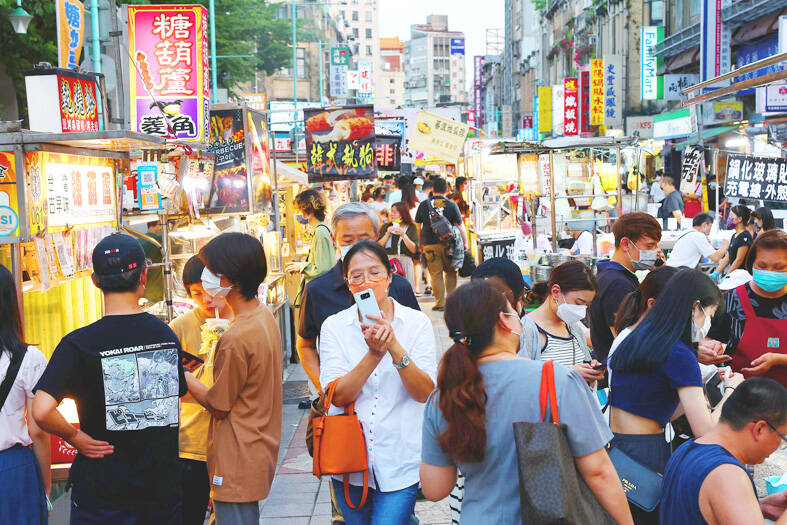Nearly 40 percent of potential tourists surveyed said they are interested in visiting Taiwan this year, with food cited as the biggest draw, a poll released on Monday by a travel-related news Web site showed.
The findings were part of a report that the Chinese-language Xinmedia, which is affiliated with Lion Travel Service Co (雄獅旅行社), presented during a global travel forum on trends related to travel to Taiwan this year.
Although the report referred to respondents generally as “international tourists,” most participants were Asian, with 33 percent from South Korea; 22 percent from Japan; 17 percent from China, Hong Kong and Macau; and 12 percent from Southeast Asia.

Photo: CNA
The survey showed that more than 50 percent of the respondents planned to travel to Taiwan within the next two years, while nearly 40 percent hoped to visit this year.
Regarding why they wanted to visit Taiwan, the top three reasons cited by respondents were Taiwan’s specialty foods (60.7 percent), natural scenery (43.9 percent) and safe environment (22.8 percent).
Among those interested in traveling to Taiwan, 38 percent said they would visit through custom tour packages, 35 percent said they would purchase one-day tours in Taiwan through online travel platforms and 27 percent said they would opt for group tours arranged by travel agencies.
Nearly 40 percent of the respondents said they were willing to spend more than US$1,000 on a trip to Taiwan and were willing to spend more for restaurants, accommodation and activities that offer localized experiences.
The survey also found that 50 percent of respondents who wanted to visit Taiwan would stay for three to five days, followed by 23 percent who would stay one to two days and 17 percent who would stay for five to seven days.
The top five tourist destinations cited in the survey were Taipei (74.2 percent) and Kaohsiung (32.8 percent), followed by New Taipei City, Tainan and Hualien County, the survey found.
The most popular travel experience cited was “night market shopping” (43.4 percent), followed by city tours and green tourism, while the most popular food was xiaolongbao, small steamed dumplings.
The choices of the relatively small number of European and American respondents differed significantly from those of Asian tourists.
They said they would prefer to spend seven to 10 days in Taiwan, with Taitung County and outlying islands given as the most popular tourist destinations, Xinmedia said in the report.
The survey was conducted between Jan. 3 and Feb. 9, with 3,011 valid questionnaires collected.

CHIP RACE: Three years of overbroad export controls drove foreign competitors to pursue their own AI chips, and ‘cost US taxpayers billions of dollars,’ Nvidia said China has figured out the US strategy for allowing it to buy Nvidia Corp’s H200s and is rejecting the artificial intelligence (AI) chip in favor of domestically developed semiconductors, White House AI adviser David Sacks said, citing news reports. US President Donald Trump on Monday said that he would allow shipments of Nvidia’s H200 chips to China, part of an administration effort backed by Sacks to challenge Chinese tech champions such as Huawei Technologies Co (華為) by bringing US competition to their home market. On Friday, Sacks signaled that he was uncertain about whether that approach would work. “They’re rejecting our chips,” Sacks

NATIONAL SECURITY: Intel’s testing of ACM tools despite US government control ‘highlights egregious gaps in US technology protection policies,’ a former official said Chipmaker Intel Corp has tested chipmaking tools this year from a toolmaker with deep roots in China and two overseas units that were targeted by US sanctions, according to two sources with direct knowledge of the matter. Intel, which fended off calls for its CEO’s resignation from US President Donald Trump in August over his alleged ties to China, got the tools from ACM Research Inc, a Fremont, California-based producer of chipmaking equipment. Two of ACM’s units, based in Shanghai and South Korea, were among a number of firms barred last year from receiving US technology over claims they have

It is challenging to build infrastructure in much of Europe. Constrained budgets and polarized politics tend to undermine long-term projects, forcing officials to react to emergencies rather than plan for the future. Not in Austria. Today, the country is to officially open its Koralmbahn tunnel, the 5.9 billion euro (US$6.9 billion) centerpiece of a groundbreaking new railway that will eventually run from Poland’s Baltic coast to the Adriatic Sea, transforming travel within Austria and positioning the Alpine nation at the forefront of logistics in Europe. “It is Austria’s biggest socio-economic experiment in over a century,” said Eric Kirschner, an economist at Graz-based Joanneum

BUBBLE? Only a handful of companies are seeing rapid revenue growth and higher valuations, and it is not enough to call the AI trend a transformation, an analyst said Artificial intelligence (AI) is entering a more challenging phase next year as companies move beyond experimentation and begin demanding clear financial returns from a technology that has delivered big gains to only a small group of early adopters, PricewaterhouseCoopers (PwC) Taiwan said yesterday. Most organizations have been able to justify AI investments through cost recovery or modest efficiency gains, but few have achieved meaningful revenue growth or long-term competitive advantage, the consultancy said in its 2026 AI Business Predictions report. This growing performance gap is forcing executives to reconsider how AI is deployed across their organizations, it said. “Many companies